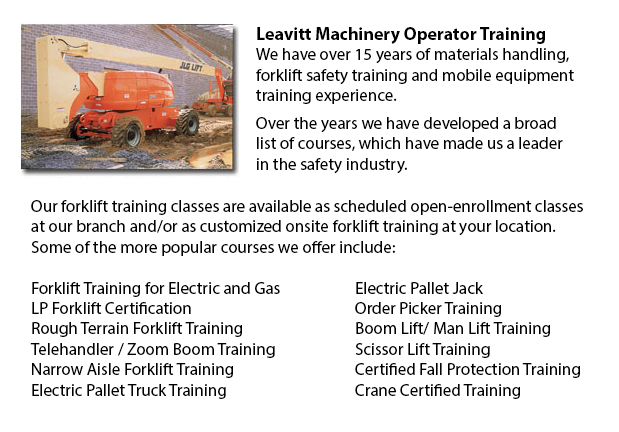
Boom Lift Safey Training Fort Mcmurray - Boom lifts fall under the category of elevated work platform or aerial lifting device. Most commonly used in industry, warehousing and construction; the boom lift is so versatile that it could be utilized in virtually any environment.
Elevated work platforms allow workers to get into work areas which would be not reachable otherwise. There is inherent danger in the operation of these devices. Workers who operate them have to be trained in the right operating techniques. Accident prevention is paramount.
The safety aspects which are included in using boom lifts are covered in our Boom Lift Training Programs. The course is suitable for individuals who operate self-propelled elevated work platforms and self-propelled boom supported elevated work platforms. Upon successful completion of the course, Individuals who participated would be issued a certificate by somebody licensed to verify finishing a hands-on assessment.
Industry agencies, local and federal regulators, and lift manufacturers all play a role in establishing standards and providing information to be able to help train operators in the safe use of elevated work platforms. The most important ways in preventing accidents connected to the utilization of elevated work platforms are the following: performing site assessments; checking machinery; and wearing safety gear.
Vital safety factors when operating Boom lifts:
Operators have to observe the minimum safe approach distance (or also called MSAD) from power lines. Voltage can arc across the air to be able to find an easy path to ground.
So as to maintain stability as the platform nears the ground, a telescopic boom should be retracted prior to lowering a work platform.
Personnel working from the platform of a Boom lift should tie off so as to guarantee their safety. lanyard and safety harness combinations should not be attached to any anchorage other than that provided by the manufacturer, never to other poles or wires. Tying off may or may not be necessary in scissor lifts, depending on specific job risks, local regulations, or employer guidelines.
Avoid working on a slope which goes beyond the maximum slope rating as specified by the manufacturer. If the slop goes beyond requirements, therefore the equipment must be winched or transported over the slope. A grade could be measured without problems by laying a minimum 3-feet long straight board or edge on the slope. Then a carpenter's level can be laid on the straight edge and raising the end until it is level. The percent slope is obtained by measuring the distance to the ground (the rise) and then dividing the rise by the length of the straight edge. After that multiply by one hundred.
-
Telehandler Training Fort Mcmurray
Telehandler Training Fort Mcmurray - Telehandlers or also called Telescopic handlers are very popular piece of heavy construction equipment most often utilized in agriculture and construction industries. These machines have extreme reaching capabilit... More -
Counterbalance Forklift Training Fort Mcmurray
Counterbalance Forklift Training Fort Mcmurray - Counterbalance Forklift Training courses are always in high demand. The Counterbalance forklift is a forklift that is made along with a weight that counters the balance, evenly spreading the weight of... More -
Heavy Equipment Training School Fort Mcmurray
Heavy Equipment Training School Fort Mcmurray - HEO or the heavy equipment operator courses will provide you with the knowledge and skills required in order to enter the workforce as an entry level heavy machine operator. In this 12 week course in ad... More -
Operator Safety Training, Re-Qualification Training, In-House Instructor Training in Fort McMurray
Used in just about all boat yards, industrial construction sites or warehouse operations, the forklift is a very important component in order to help pick up and transfer supplies. The reach feature of a lift truck could help improve the applications... More -
Heavy Equipment License Fort Mcmurray
Heavy Equipment License Fort Mcmurray - A heavy equipment license can be obtained by finishing a certification and preparation course at a private training school or a vocational school. This license would qualify you to operate various types of heav... More -
Boom Lift License Fort Mcmurray
Boom Lift License Fort Mcmurray - To operate an aerial boom lift, operators must be licensed through training that can be obtained utilizing both practical training and classroom sessions and by obtaining a boom lift license. Instruction must be give... More -
Skid Steer Loader Training in Fort McMurray
A skid-steer loader is actually an engine powered machine that consists of a small and rigid frame. It is outfitted along with lift arms which are used to attach to different labor saving attachments and tools. Normally, skid-steer loaders are four-w... More -
Order Picker Ticket Fort Mcmurray
Order Picker Ticket Fort Mcmurray - Order picker's enables warehouse employees to lift pallets using forks. Likewise called a stock picker, this electrically-powered equipment is like a forklift except that an order picker is likewise utilized to lif... More

Forklift Training Fort McMurray
TOLL FREE: 1-888-254-6157
Fort McMurray, Alberta
forklifttrainingfortmcmurray.com
Email Us
About Us


